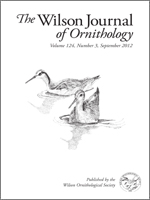We document the breeding behavior of the Red-bellied Grackle (Hypopyrrhus pyrohypogaster: Icteridae) from monitoring seven breeding groups during 4 consecutive years (2006–2009) in the central cordillera of the Colombian Andes. All nests were attended by three to seven individuals, representing family groups composed of adult males and females, as well as immatures from previous generations. Clutch size ranged from two to four eggs and was positively correlated with family group size. The incubation period was 15–17 days and nestlings left the nest when 16–18 days of age. Nestling success was relatively low (0.39), and mortality was caused by predation and harsh environmental events; however, groups attempted to breed after nest failures. The Red-bellied Grackle has a cooperative breeding system and individuals delay dispersal by remaining in natal territories.
How to translate text using browser tools
1 September 2012
Breeding Biology of the Red-Bellied Grackle (Hypopyrrhus pyrohypogaster): A Cooperative Breeder of the Colombian Andes
David Ocampo,
M. Camila Estrada-F,
Jenny M. Muñoz,
Laura V. Londoño,
Santiago David,
Giovanny Valencia,
Paula A. Morales,
Jaime A. Garizábal,
Andrés M. Cuervo
ACCESS THE FULL ARTICLE





